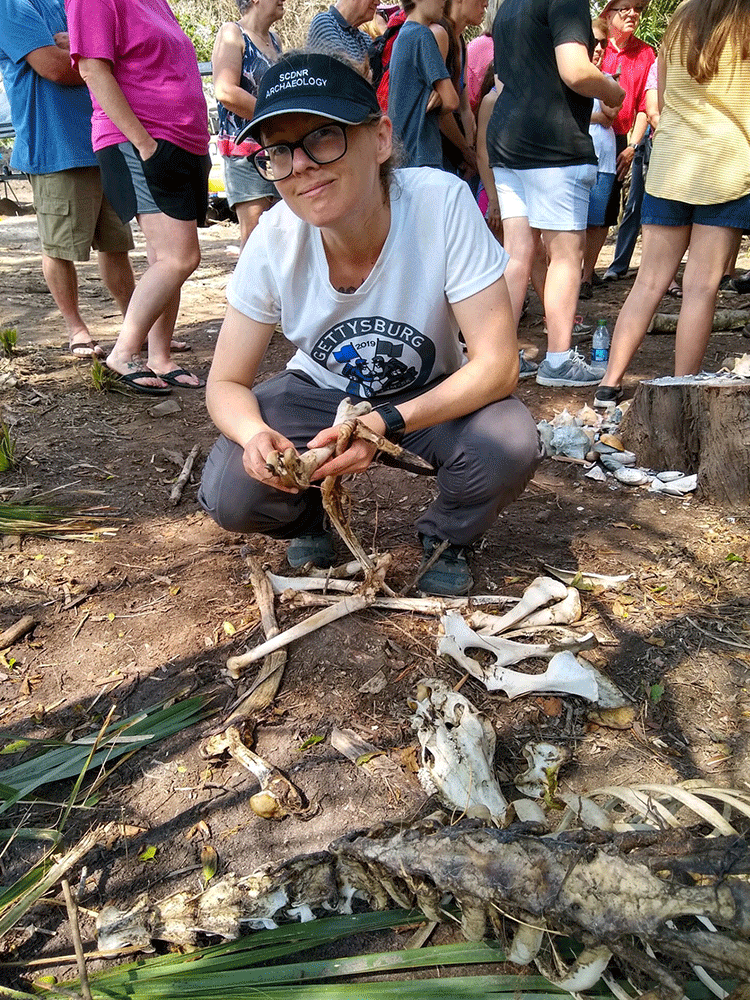Indiana University of Pennsylvania has been selected by the Department of Defense POW/MIA Accounting Agency through the Henry M. Jackson Foundation for the Advancement of Military Medicine Inc. to continue its field study in Germany at the site of a December 1944 crash of a World War II B-17 airplane.
Additional Resources
Department of Defense POW-MIA Accounting Agency
IUP Department of Anthropology, Geospatial and Earth Sciences
The project is directed by anthropology faculty members Andrea Palmiotto and William Chadwick in IUP’s Department of Anthropology, Geospatial and Earth Sciences, and takes place from June 15 to July 26.
This is the fifth year that IUP has received funding from the DPAA and HJF for study at a World War II airplane crash site.
In summer 2021, Palmiotto and Chadwick led IUP students at a field school near Gifhorn, Germany, at the site of a World War II B-24 plane crash. They began work at the crash site in Baden-Württemberg, Germany, where this year’s field study will take place, in 2022 and returned to the site in summer 2023 and 2024.
The mission of the DPAA is to provide the fullest possible accounting for missing personnel from past conflicts of the United States. The Henry M. Jackson Foundation focuses on the development of research protocols, new technologies, and operational frameworks that improve health diagnostics, treatment, delivery, and disease prevention for veterans, active duty military and their families, and civilians.

Andrea Palmiotto
This year’s field study includes six IUP students, joining 10 students from other universities across the United States. This includes students from Temple University; James Madison University; University of Nevada, Reno; Franklin and Marshall University; Kenyon College; Colorado State University; University of Cincinnati; Hood College; University of Evansville, Indiana; and Brigham Young University.
Two of the IUP students are in the Applied Archaeology master’s program and will gain supervisory experience through this opportunity.
“It continues to be an honor to conduct this important work in support of the DPAA mission,” Palmiotto said. “We are very happy to offer students this international applied archaeology experience while contributing to the recovery of American service members,” she said.
Palmiotto holds the highest professional certification through the American Board of Forensic Anthropology and is one of two American Board of Forensic Anthropology diplomates currently working in Pennsylvania. In addition to her work with DPAA and HJF, she provides consultation on unknown skeletal cases for law enforcement professionals and medicolegal specialists in Western Pennsylvania and surrounding areas.
Prior to joining the IUP faculty, she was a research fellow and then a forensic anthropologist for the DPAA, working at agency laboratories in Nebraska and Hawaii. She worked on cases related to WWII, the Korean War, and the Vietnam War, and led archaeological recovery efforts in Vietnam and Laos.

William Chadwick
Chadwick also brings extensive experience in applied archaeology. He is a registered professional archeologist and licensed professional geologist who has broad experience in both geoarchaeology and archaeology. Prior to joining the IUP faculty, he worked within the cultural resource management industry as a consultant for more than 20 years.
While the students will not be analyzing any materials that they find—that will be done by the DPAA—the field school provides an opportunity for the students to make and properly document the discoveries.
IUP’s program, especially the master’s program in Applied Archaeology, continues to get recognition for providing students with practical experiences outside of the classroom, Chadwick said.
“This kind of project is one of the things that makes IUP’s program stand out, both at the undergraduate and graduate levels,” Chadwick said.
“We constantly get feedback from employers about how well prepared and trained our graduates are when they enter the workforce. IUP has been recognized as being typically within the top 10 schools each year producing registered professional archaeologists in the nation, and our program is recognized by the American Cultural Resources Association,” he said.
About the DPAA
 DPAA combined the functions of the former Defense Prisoner of War/Missing Personnel Office, the Joint Prisoner of War/Missing in Action Accounting Command, and the Artifacts section of the Life Sciences Equipment Laboratory. DPAA today is comprised of more than 600 highly skilled and talented civilians and military from each of our services (Army, Navy, Marines, and Air Force) and includes historians, research analysts, policy experts, anthropologists, archivists, archaeologists, odontologists, linguists, logisticians, communication experts, field operators, material evidence experts, strategists, and planners, as well as numerous additional support personnel. These professionals with a wide variety of backgrounds and specialties are integral to the successful day-to-day operations of their important mission.
DPAA combined the functions of the former Defense Prisoner of War/Missing Personnel Office, the Joint Prisoner of War/Missing in Action Accounting Command, and the Artifacts section of the Life Sciences Equipment Laboratory. DPAA today is comprised of more than 600 highly skilled and talented civilians and military from each of our services (Army, Navy, Marines, and Air Force) and includes historians, research analysts, policy experts, anthropologists, archivists, archaeologists, odontologists, linguists, logisticians, communication experts, field operators, material evidence experts, strategists, and planners, as well as numerous additional support personnel. These professionals with a wide variety of backgrounds and specialties are integral to the successful day-to-day operations of their important mission.
Personnel from DPAA, along with other US and foreign specialists, research, investigate, recover, and identify remains of Americans unaccounted for from World War II, the Korean War, the Vietnam War, the Cold War, and the Iraq and Persian Gulf Wars. When recovery operations are unsuccessful, DPAA professionals work hand-in-hand with Service Casualty Officials to provide answers to family members on the fate of their loved ones.
The analysis and investigation sections also provide historical analysis to help with the identification of recovered remains. At any given time, there are more than 1,000 active cases under analysis.